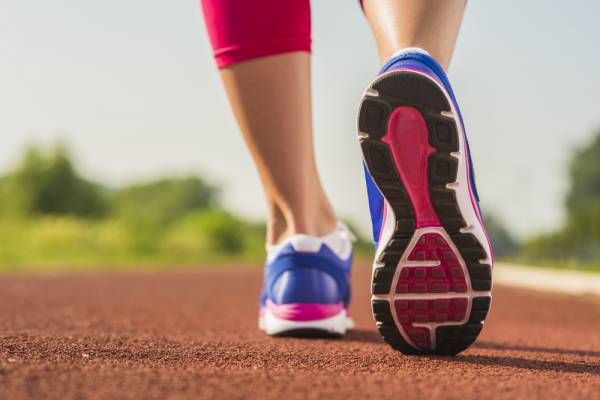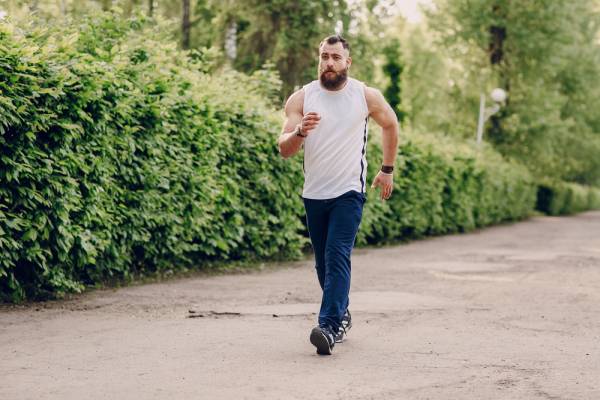Most people who follow my work know my stance on barefoot and minimalist training. If you don’t know me or my work, know that I’m a huge advocate. Today, I want to get a bit more into the science side of what happens when our heel strikes the ground during gait. We’re going to talk about forces, and more specifically, impact forces – how important they are and how crucial it is that we are prepared to handle them.
Because this is a topic I could talk about for days, I’m going to break it down into two parts so I don’t get going on an epic journey and lose you halfway through. So, for now, grab a coffee and enjoy part one of Impact Forces, Shoes, and Lower Leg Injuries. And don’t worry – part two will go into specific injuries and what you can do about them.
Let’s Talk Impact Forces
Put simply, impact forces refers to the force that is absorbed from striking the ground. To put it in context, when you walk and strike the ground, you are creating an impact force of one to 1.5 times your body weight. Running increases this to three to four times body weight, doing anything ballistic up to ten times, and tumbling in gymnastics can create impact forces up to eighteen times your body weight, all of which are happening very quickly.
You can see from these numbers that to perform these activities we must be able to withstand a huge amount of force going through our body over a short period of time and on a continuous basis. When we are completely dissociated from the ground and/or when we are not in control of how these impact forces are absorbed by our body, impact injuries of the lower leg occur.
“You need impact. It gives you energy to move. In fact, without impact you would have to work a whole lot harder.”
Did you know some people get stress fractures simply from walking to work? They are so deconditioned and so dissociated from the ground that they can’t even handle the impact forces of walking. And this is not abnormal. This is becoming common. In fact, as a physical therapist I see this as well as a number of similar injuries that are entirely preventable, like shin splints, Achilles tendonitis, and plantar fasciitis.
When it comes to the lower leg, what is imperative for injury prevention is that you can anticipate the ground and therefore anticipate the impact forces so you can store and use them as elastic energy with minimal loss. The problem is that most people simply react to these forces. You’ll see later why this is a problem.
Impact Is Not a Bad Thing
A lot of people believe they need to minimize impact in order to prevent injury. Add some cushion to your shoes, and that will take away the impact and prevent injury, right? This is actually flawed thinking. You need impact. It gives you energy to move. In fact, without impact you would have to work a whole lot harder. When your body perceives impact, it damps (receives) the impact in such a way that it stores it as potential energy to be used later. This means your body has to work less due to all this energy, which essentially cost you nothing.
So, know that impact isn’t a bad thing. It is an inevitable and useful thing. You just need to be ready for it.

What Happens When Your Heel Strikes the Ground
A couple of things happen very quickly when it comes to your foot absorbing impact:
- You perceive the forces through vibration (impact forces are vibration). You detect this through the many small proprioceptive nerves on the skin on the sole of your foot (something to think about for later: shoes get in the way of this).
- You damp (receive) the vibrations. Many people believe this is done through eccentric muscle contraction, but the truth is that from the knee down (where most impact injuries occur) this happens through isometric contractions. Now, in order to make clear how this happens, I need to back up a bit and explain some anatomy and physiology.
In our lower limbs, our muscles are housed in a compartment that is created by the thick fascia that surrounds them. When muscles isometrically contract, this creates pressure that causes the pressure of the entire compartment to increase. We want this. This creates stiffness in the muscles, and turns the compartment into a sort of splint.
“To successfully deal with impact forces, you must anticipate them – not simply react to them.”
This “splint” accomplishes two things. It makes it so the vibrations cannot go through and provides support to the bone. Both of these things are crucial, because without the body’s ability to do this the vibrations would be transferred from the soft tissue that are meant to anticipate them into our bone, and we most definitely do not want that. If this happens and if the bone is inadequately splinted, it will bend slightly and this is what leads to injuries such as shin splints.
To successfully deal with impact forces, you must anticipate them – not simply react to them. To efficiently dampen vibration, you utilize your fast twitch muscle fibers. The challenge is that impact forces peak at under 50ms after first contact, while fast twitch muscle fibres don’t peak until 70ms. This is why you must anticipate, not react, so you have enough time to efficiently and effectively damp the vibrations.
Store and Use Energy
Once damped, the impact forces are then stored as potential energy in your connective tissue, in the contractile units of your fascia. The potential energy is used as elastic energy. For this to be efficient, you need to be stiff before heel strike (remember what we talked about regarding compartment pressure). If muscle contraction is not happening in time, stiffness will be low and energy will be leaked.
Going back to shin splints, consider that they often happen when a runner is fatigued. That is because when fatigued the muscles aren’t contracting fast enough or high enough causing low stiffness and compartment pressure that isn’t peaking in time to deal with the impact forces of running.

To understand how this potential energy is then used to your advantage, think about walking. Once you hit your mid-stance, your Achilles and plantar fascia are stretched like rubber bands, and then they recoil. This recoil is when we convert potential energy to energy we can use. The recoil releases stored energy that adds force to your muscles that doesn’t require much work from you.
How Does Footwear Fit In?
Remember how I talked about the importance of creating pressure within the compartment to keep vibrations from moving on or from going in to the bones? Well, you actually have four compartments in your lower leg and nine in your foot.
If you wear shoes or orthotics what happens is this – the muscles in your feet get weak, lazy, and atrophy. This means your shoe damn well better be taking in and damping the vibrations for you because your body no longer has any idea how to do it. And if your shoes aren’t doing this, then look out because you’re an injury waiting to happen.
“If you wear shoes or orthotics what happens is this – the muscles in your feet get weak, lazy, and atrophy.”
Now, it would be inconceivable to expect people to never wear shoes, but you absolutely need to do some barefoot training. This will help to not only strengthen your feet, but to also train them to build compartment pressure.
Coming Up
I mentioned that I could talk for days on this, so I will leave you with this: letting the muscles of your feet get weak, atrophied, and lazy will lead to a lower limb injury. I can guarantee it. Weak, lazy feet mean you cannot properly perceive, damp, or store vibration, nor can you then use that potential energy. This can lead to lower limb injuries including shin splints, Achilles tendonitis, plantar fasciitis, and stress fractures.
In part two, I will break down each of the injuries mentioned above and help you develop a plan to prevent them from happening.
More like this:
- The Simple Path to Minimalist Running
- Minimalist Training 2.0: The How and Why
- A 12-Step Plan for Transitioning to Minimalist Running Shoes
- New On Breaking Muscle Today
References:
1. Dr. Emily Splichal. The Art of Movement Efficiency. Perform Better Functional Training Summit. Perform Better. Providence, Rhode Island, US. July 19, 2015.
Photos courtesy of Shutterstock.






